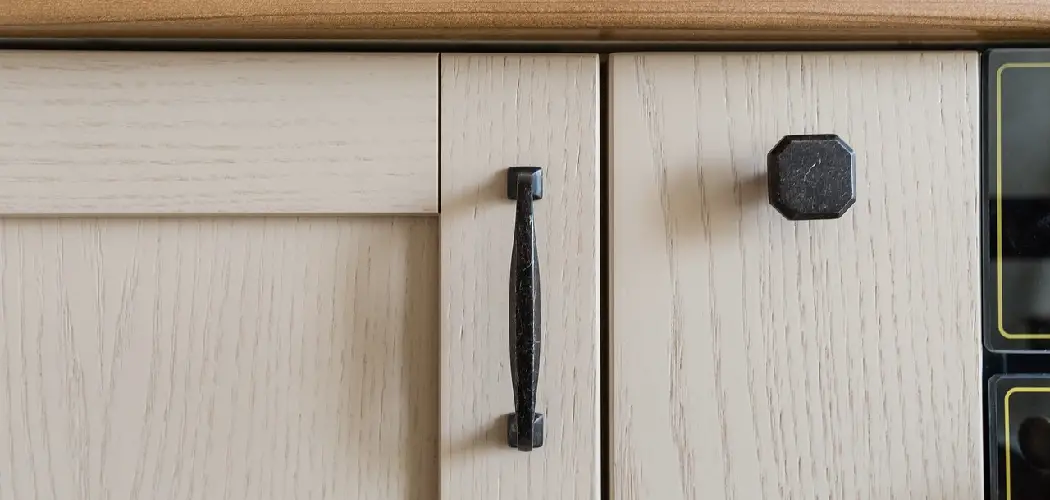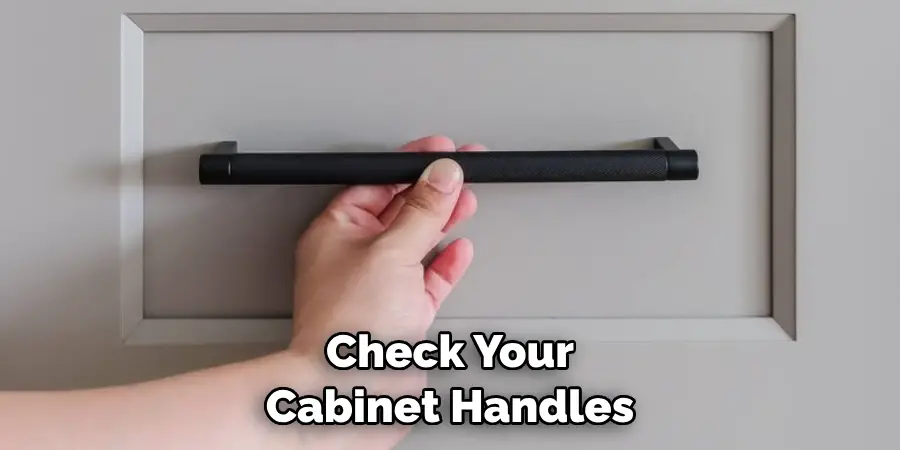Identifying the Problem

Before you start fixing crooked cabinet handles, it’s important to understand the root cause of the problem. There are several reasons why a handle might be crooked, and knowing the cause will help you choose the right solution.
Types of Crooked Cabinet Handles
Different types of crooked cabinet handles can be identified. A handle might be crooked because it is loose, warped, or damaged.
- Loose Handles: This is the most common type of crooked handle. It’s usually caused by loose screws or a worn-out mounting plate.
- Warped Handles: Warped handles are often caused by exposure to heat or moisture. They may bend or twist out of shape, making them appear crooked.
- Damaged Handles: Damaged handles can be caused by impact, such as a dropped object. This can lead to a bent or broken handle, resulting in a crooked appearance.
Determining the Cause of Crookedness
To determine the cause of the crookedness, carefully inspect the handle and the cabinet door.
- Inspect the Handle: Check for any signs of damage, such as cracks, bends, or broken parts. Also, look for any loose screws or a worn-out mounting plate.
- Inspect the Cabinet Door: Examine the cabinet door for any signs of warping or damage. If the door is warped, it can cause the handle to appear crooked, even if the handle itself is fine.
Fixing Crooked Cabinet Handles: How To Fix Crooked Cabinet Handles
Now that we’ve identified the problem, let’s move on to fixing those crooked cabinet handles. It’s a simple fix, but there are a few methods you can use depending on the situation.
Tightening Loose Screws, How to fix crooked cabinet handles
Often, the culprit behind a crooked handle is a loose screw. Tightening it can be the easiest solution. Here’s how:
- Gather your tools: You’ll need a screwdriver that fits the screw head on your handle.
- Locate the screw: It’s usually located on the back of the handle, near the mounting plate.
- Tighten the screw: Hold the handle in place with one hand and use the screwdriver to tighten the screw. Be careful not to overtighten, as this can damage the handle or the mounting plate.
Adjusting Handle Position
If tightening the screw doesn’t solve the problem, you may need to adjust the handle’s position. This is usually done with a screwdriver:
- Locate the adjustment screws: These screws are usually found on the sides of the handle.
- Use a screwdriver: Gently turn the adjustment screws to move the handle up, down, left, or right.
- Test the position: After each adjustment, check if the handle is now straight.
Methods for Fixing Crooked Handles
Here’s a table comparing different methods for fixing crooked handles:
| Method | Description | Advantages | Disadvantages |
|---|---|---|---|
| Tightening Loose Screws | Tighten the screw holding the handle in place. | Quick and easy. | May not work if the screw is stripped or the hole is damaged. |
| Adjusting Handle Position | Use adjustment screws to move the handle into the desired position. | Can be used to fine-tune the handle’s alignment. | May not work if the handle is missing adjustment screws or the mounting plate is damaged. |
| Using Shims | Place thin pieces of material (like cardboard or wood) between the handle and the mounting plate to level the handle. | Can be used to adjust the handle’s height or angle. | May not be a permanent solution and can be noticeable if the shims are too thick. |
| Replacing Screws | Use longer screws or screws with a different thread size. | Can provide a more secure hold for the handle. | May not be possible if the screw holes are too small or the mounting plate is too thin. |
Preventing Future Crookedness

Now that you’ve fixed your crooked cabinet handles, you want to make sure they stay that way. The right handle and a little preventative care will keep your cabinets looking sharp for years to come.
Choosing the Right Cabinet Handle
Choosing the right cabinet handle is essential for preventing future crookedness. Here are some factors to consider:
- Material: Handles made from sturdy materials like solid brass, stainless steel, or high-quality zinc alloys are less prone to bending or breaking over time. Avoid handles made from lightweight materials or thin metal, which are more likely to become crooked.
- Construction: Look for handles with a solid, well-constructed design. Avoid handles with flimsy parts or weak attachment points, which could easily become loose or crooked.
- Mounting Style: Consider the mounting style of the handle. Handles with concealed mounting hardware are generally more durable and less prone to becoming loose or crooked.
- Weight: Heavy handles are more likely to become crooked over time, especially if they’re attached to lightweight cabinets. Choose a handle that’s appropriately sized for the weight of the cabinet door.
Preventative Measures
How to fix crooked cabinet handles – Regular maintenance and proper installation are key to preventing crooked cabinet handles.
- Proper Installation: Ensure the handle is installed securely with the appropriate screws and hardware. Use a level to ensure the handle is installed straight, and tighten screws firmly but avoid overtightening.
- Regular Maintenance: Periodically check your cabinet handles for signs of looseness or wear. Tighten screws if necessary and consider applying a light coating of oil to the hinges to reduce friction and prevent wear.
- Avoid Overuse: While this may seem obvious, avoid putting excessive stress on your cabinet handles. For example, don’t hang heavy objects on them or use them to pull open drawers that are jammed.
Cabinet Handle Inspection Checklist
A regular inspection can help catch potential issues before they become a problem. Here’s a checklist to help you:
- Check for Looseness: Gently wiggle each handle to see if it’s loose. If it moves, tighten the screws or replace the hardware.
- Inspect for Wear: Look for any signs of wear or damage on the handle or mounting hardware. Replace any worn or damaged parts.
- Examine the Hinges: Check the hinges for signs of wear or rust. Apply a light coating of oil to the hinges if needed.
- Check for Alignment: Ensure the handles are still aligned with the cabinet doors. If they’re crooked, readjust them or tighten the screws.
Fixing crooked cabinet handles often involves adjusting the screws or the mounting plate. However, if you’re dealing with a cabinet that’s too small or too large for the standard handle, you might need to consider replacing it. To ensure you get the right size, it’s helpful to refer to a guide on standard bathroom cabinet sizes.
This will give you an idea of the typical dimensions and help you choose a handle that’s the perfect fit. Once you’ve got the right handle, you can easily install it and enjoy a functional and stylish bathroom.
Fixing crooked cabinet handles is a common DIY task, often requiring simple adjustments or even replacing the screws. This can be especially important in spaces like your bathroom, where you might have a bathroom vanity cabinets 60 with double sink that sees heavy daily use.
A well-maintained handle not only enhances the look of your cabinets but also ensures their functionality and longevity.

